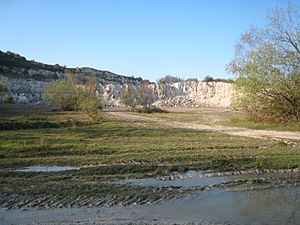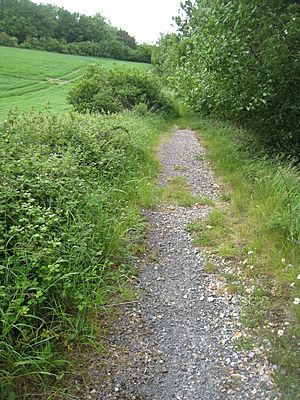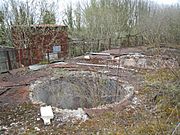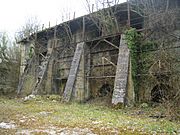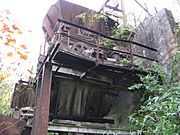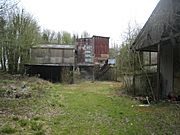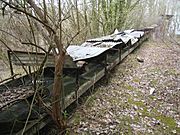Cocking Lime Works facts for kids
|
Trade name
|
Cocking Lime Works |
|---|---|
| Traded as | Midhurst Whites |
| Industry | Chalk quarrying and lime production |
| Defunct | 1999 |
| Headquarters | |
|
Key people
|
Benjamin Cloke |
The Cocking Lime Works and its nearby chalk quarry are old industrial sites in the beautiful South Downs area of England. They are located south of the village of Cocking, West Sussex, not far from the South Downs Way walking path. These sites are on land owned by the Cowdray Estate and are not open to the public.
Cocking was an important place for making lime. This lime was used to create special "Midhurst White" bricks and also for farming to improve soil.
Contents
Where are the Lime Works?
The lime kilns are right next to the A286 road. They are about half a kilometer (0.3 miles) south of the village of Cocking. You can find them in a small chalk pit, which is now very overgrown with plants. This area is about 3 hectares (7.4 acres) big and is known as "The Butts." Long ago, in the 12th century, people used this spot for archery practice!
The chalk quarry is a bit further away, about 500 meters (0.3 miles) to the south-east. It sits higher up, about 80 meters (260 feet) above the kilns, and covers a larger area of about 6 hectares (14.8 acres). In 1962, a special raised road was built to connect the quarry and the kilns. This allowed lorries (trucks) to carry chalk directly from the quarry to where the lime was made.
History of the Lime Works
Early Days of Lime Production
People have been working with lime in Cocking for a very long time. The first records mentioning lime workings here date back to 1715. Documents from the Cowdray Estate show that two separate lime kilns were already in use then.
Maps from 1768 show a chalk pit on Cocking Hill. Later, in 1842, a map shows the chalk pit belonged to Rev. Thomas Valentine, who was the local church leader. By 1830, more lime kilns were shown on maps at Wolverstone Farm, on the southern edge of the area.
The 1861 Census even mentions "James Bennett, a tramp, slept in lime kiln" in Cocking. Another person, Henry Farley, was listed as a "Limeburner and timber merchant." Older maps from 1874 show three lime kilns in the area. These early kilns were likely small, burning wood to produce a type of grey lime.
Growing the Business
Over the years, the Cowdray Estate leased the chalk pits and lime kilns to different people. In 1906, a company called Pepper and Sons took over two kilns. One of them was in good working order.
In 1921, Frederick Searle leased the site, and later his brother Eli took over. Eli then partnered with Robert Dunning in 1924. They planned to build new kilns where the old ones used to be. The next year, Dunning bought the Midhurst Brickworks. This brickworks had been making bricks from sand and lime since 1913.
In 1926, Benjamin Cloke became the owner of the Midhurst Brick & Lime Company. This meant he also owned the lime works at Cocking. The site kept running until 1999 when all work stopped, and the works were left abandoned.
How the Works Operated
In the beginning, chalk was dug out by hand, and the lime kilns were built very close by. As the pits got deeper, workers would hang from ropes to break the chalk. It wasn't until the 1940s that explosives were used to blast the chalk from the quarry walls. Blasting happened a few times a week, often on Sunday mornings. This caused many complaints from the people in Cocking village about cracked ceilings and broken windows!
The lime works started to get much bigger in 1906. By 1914, a narrow railway track (called a tramway) was built. This tramway connected the lower chalk pit to the lime kiln. You can still find parts of this old tramway on the site today, including pieces of rail and a truck chassis.
When Robert Dunning took over in 1924, the works expanded a lot to supply the Midhurst Brickworks. Chalk was now only taken from the upper chalk pit. An overhead ropeway was built to quickly move chalk from the pit to the kilns. Around this time, six new "draw kilns" were built. These are now the main part of the south battery of kilns.
The site continued to grow in the 1920s and 1930s. Another group of four kilns was built. A large overhead crane was put in place to move chalk from the ropeway to the kilns. It also moved coal and the finished lime into the grinding plant. The original draw kilns were changed to "flare kilns." This made sure the lime was clean enough for the Midhurst White bricks. Flare kilns also needed less manual work and used less fuel.
In 1938, the company was asked to produce lime for farming. So, they installed a machine to crush chalk. The company sold a product called "Calco," which was a mix of powdered chalk and lime. They even helped farmers spread this material on their fields. A large storage shed was used to keep the Calco.
Between 1926 and 1938, the company dug out about 3,200 tons of chalk each year, all for making bricks. After 1938, the amount of chalk processed grew a lot. It reached a peak of 36,000 tons in 1955, with most of the extra chalk going towards agricultural lime.
A seventh kiln was added in the 1940s to dry chalk. An eighth kiln was built in 1958. By the late 1950s, the northern group of kilns was taken down. The overhead crane was also removed. The southern group of kilns was made bigger and changed back to draw kilns. After the crane was gone, a special excavator loaded the kilns, and a portable conveyor belt unloaded them.
In the late 1950s, the overhead ropeway was also taken down. Chalk was then brought from the quarry by road. In 1962, a new raised road was built to connect the chalk pit directly to the lime kilns.
In 1985, the company stopped making lime for bricks. After that, all production was for farming. Besides "Calco," they also made "Nurslim" for gardens and nurseries. The last new building, a primary chalk crusher, was installed in 1985.
Buildings and Structures
At the heart of the works is a row of eight lime kilns. The first six kilns were "draw kilns." They had a strong concrete wall about 6.3 meters (20.7 feet) high at the front. The kilns themselves rose another 2.9 meters (9.5 feet) above this wall. The kiln "pots" (where the chalk was burned) were about 3 meters (9.8 feet) wide at the top. They narrowed down to rectangular openings at the bottom, where the lime was removed.
The kilns at each end were added later. The one on the western (left) side sticks out a bit and is a separate structure, but the same height as the main six. It's rectangular and has its own furnace connected by a passage. The eastern kiln, built in 1958, was the last one. It's similar in size to the original six but built with concrete outer walls.
The kilns had a platform on top where they were loaded, with a railway line running across all eight.
To the south-east of the site, about 16 meters (52.5 feet) above the kilns, is the primary chalk crusher. Lorries bringing chalk from the quarry would unload here. This crusher was powered by electricity. It fed chalk from a hopper into rotating teeth, then discharged it onto a conveyor belt. This belt carried the chalk to the next crusher.
The intermediate chalk crusher is about 40 meters (131 feet) north, and its top is about 7 meters (23 feet) above the kilns. This building had several crushing machines and "ball mills" (which grind materials using balls) connected by conveyor belts. The crushed chalk was then either loaded onto lorries or sent by conveyor belt to the final screening plant.
The final screening plant was in a two-story building next to the intermediate chalk crusher. The upper floor had two sets of "Niagara" vibrating screens. These screens sorted the crushed chalk into different sizes. The sorted chalk was then either loaded onto trucks or sent to a nearby storage building.
Gallery
What's Happening There Now?
The chalk pit was officially closed in 1999. However, chalk is still sometimes dug out for local use. The quarry is still owned by the Cowdray Estate. They use it as part of their pheasant shooting activities. The estate has many shooting areas, and the chalk pit is considered one of their best spots.
In 2011, the Cowdray Estate asked for permission to use the chalk pit as a landfill site for inert (non-harmful) waste. But the local council said no to this plan.
In 2012, the Cowdray Estate suggested new ideas for the lime works site. They proposed creating camping facilities for walkers and cyclists using the South Downs Way. They also wanted to build a visitor center to teach people about the industrial history of the lime works. If this plan goes ahead, most of the old buildings would be taken down, except for the main bank of lime kilns.



